2016 Winter Youth Olympics
 | |||
| Host city | Lillehammer, Hamar, Gjøvik, and Øyer | ||
|---|---|---|---|
| Country |
| ||
| Motto | Go beyond. Create tomorrow. (Norwegian: Spreng grenser. Skap morgendagen) | ||
| Nations participating | 71 | ||
| Athletes participating | approx. 1,100 | ||
| Events | 70 | ||
| Sports | 15 | ||
| Opening ceremony | 12 February 2016 | ||
| Closing ceremony | 21 February 2016 | ||
| Officially opened by | King Harald V | ||
| Officially closed by |
Thomas Bach President of the IOC | ||
| Athlete's Oath | Maria Ramsfjell Stabekk | ||
| Coach's Oath | Sandra Alise Lyngstand | ||
| Torch lighter | HRH Princess Ingrid Alexandra | ||
| Main venue |
Lysgårdsbakkene (opening) Håkons Hall (closing) | ||
| |||
The 2016 Winter Youth Olympics (Norwegian: Vinter-OL for ungdom 2016), officially known as the II Winter Youth Olympic Games, took place in and around Lillehammer, Norway, between 12 February and 21 February 2016.[1] They were the fourth Youth Olympic Games and the second winter edition. Lillehammer was awarded the games on 7 December 2011 as the only candidate.[2] The games reused venues from the 1994 Winter Olympics. In addition to Lillehammer, sports were contested in Hamar, Gjøvik and Øyer.
Host selection

Lillehammer was the only city to bid for the games. The Norwegian Olympic Committee talked with Norwegian and regional authorities to investigate a bid and ultimately submitted a bid to the IOC. Upon the deadline for bidding, they were the only city to bid. Lillehammer hosted the 1994 Winter Olympics. They bid for the 2012 Winter Youth Olympics, but failed to become a candidate. Lake Placid, Lucerne, Zaragoza and Sofia all expressed interest in bidding but ultimately failed to submit any bids.[3][4][5][6] [7][8] On December 7, 2011, the International Olympic Committee selected Lillehammer as the host city of the 2016 Winter Youth Olympics.[9]
Organization
In January 2012, Siri Hatlen was appointed as head of the Lillehammer 2016 Organizing Committee.[10] At the Closing ceremony of the 2012 Winter Youth Olympics in Innsbruck, Lillehammer was handed the Olympic Flag.[11] Tomas Holmestad (33) is CEO of Lillehammer 2016, which holds office at Oppland Fylkeskommune. In August 2014, Lillehammer Organizing Committee counts 20 employees, and this number is expected to rise to 70-80 employees in January 2016.
Venues

Nine competition and eleven non-competition venues were used, with all except the Youth Olympic Village in Lillehammer being existing venues. The games were held in four municipalities: Lillehammer, Hamar, Gjøvik and Øyer. The former three are located nearby the lake of Mjøsa and each have about 27,000 residents, while Øyer has 5,000 residents and is located in the valley of Gudbrandsdalen. There were five competition venues in Lillehammer, two in Hamar and one in Gjøvik and Øyer.[12]
In Lillehammer, the twin ski jumping hill of Lysgårdsbakken has a spectator capacity of 35,000. Lysgårdsbakken has a hill size of 138 and a K-point of 120, while the normal hill has a hill size of 100 and a K-point of 90.[13] Birkebeineren Ski Stadium hosted cross-country skiing, biathlon and Nordic combined,[14] with the stadium itself having a capacity for 31,000 spectators during cross-country skiing and 13,500 during biathlon. In addition, spectators could watch from along the tracks.[15] Kanthaugen Freestyle Arena has a capacity for 15,000 spectators and hosted freestyle skiing and half-pipe snowboarding.[16]
Lillehammer Olympic Bobsleigh and Luge Track is located at Hunderfossen and is the only bobsleigh, luge and skeleton track in the Nordic Countries.[17] Kristins Hall hosted both ice hockey and curling.[18] Gjøvik Olympic Cavern Hall is located in a man-made cave and featured the short track speed skating events.[19] In Hamar, Vikingskipet hosted long track speed skating and Hamar Olympic Amphitheatre hosted figure skating.[20] Alpine skiing and slopestyle snowboarding were undertaken at Hafjell in Øyer.[21]
Stampesletta, a multi-sports complex next to Kristins Hall, hosted the opening and closing ceremonies. The medal ceremonies took place in the town plaza. Athletes and leader accommodation were provided at two Olympic Villages, one in Lillehammer for the Lillehammer and Øyer-based events, and one in Hamar for the Hamar and Gjøvik-based events. The Lillehammer village consisted of student apartments in combination with a hotel and apartment resort. They used Håkons Hall for dining. The Hamar village was Hotel Scandic Hamar.[22] In addition, there are five designated cultural venues in Lillehammer: Kulturhuset Banken, Lillehammer Art Museum, Lillehammer University College, Maihaugen and the Nansen Academy.[23] The Main Media Centre was located at Mesna Upper Secondary School, which is adjacent to Stampesletta.[24]
All the competition venues were built ahead of the 1994 Winter Olympics.[25] Kristins Hall is the only venue not used during those Games,[26] while Håkons Hall and Kvitfjell were used. During Lillehammer 2016 Youth Olympic Games, Håkonshall was the venue for the Learn & Share program, whilst Kristins Hall was the official venue for ice hockey and curling. Kvitfjell was not used, and Hafjell was the main venue for downhill skiing, snowboard, and friskiing instead.
Marketing
Mascot

Lillehammer organizing committee launched an international mascot design competition in March and April 2014. The competition required that the design proposals would be on an animal (ordinary animal or a fantasy one), look youthful, be kind and open, sporty, and represent the look of Lillehammer 2016 Winter Youth Olympic Games. LYOGOC received over 50 proposals from all over the world, and a jury consisting of Birgit Skarstein, Julie Strømsvåg, Simen Staalnacke, and Marianne Aagotnes, selected three finalists. The final proposals were presented on the official Facebook page of Lillehammer 2016, where fans could vote on their favorite. It was the Lynx that won the competition, designed by 19-year-old Line Ansethmoen.
The Games
Sports
The Youth Olympic Games featured 7 sports and 15 disciplines.[27]
-
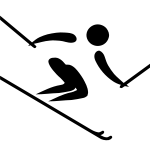 Alpine skiing (9) ()
Alpine skiing (9) () -
 Biathlon (6) ()
Biathlon (6) () -
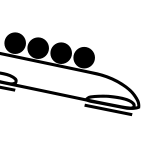 Bobsleigh (2) ()
Bobsleigh (2) () -
 Cross-country skiing (6) ()
Cross-country skiing (6) () -
 Curling (2) ()
Curling (2) () -
 Figure skating (5) ()
Figure skating (5) () -
 Freestyle skiing (6) ()
Freestyle skiing (6) () -
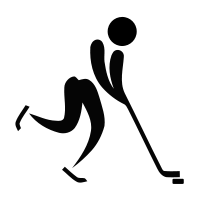 Ice hockey (4) ()
Ice hockey (4) () -
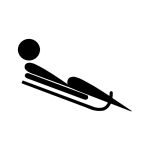 Luge (4) ()
Luge (4) () -
 Nordic combined (2) ()
Nordic combined (2) () -
 Short track speed skating (5) ()
Short track speed skating (5) () -
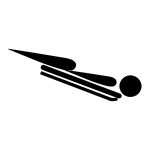 Skeleton (2) ()
Skeleton (2) () -
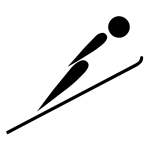 Ski jumping (3) ()
Ski jumping (3) () -
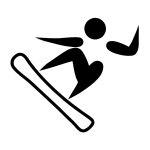 Snowboarding (7) ()
Snowboarding (7) () -
 Speed skating (7) ()
Speed skating (7) ()
- Nordic Team Event included with cross country skiing.
- Team ski-snowboard cross included with snowboarding.
New events
A number of events have been added to the programme.[28]
- Biathlon (1)
- Single mixed relay
- Bobsleigh (2)
- Monobob race (boys/girls)
- Cross-country skiing (2)
- Cross-country cross (boys/girls)
- Freestyle skiing (2)
- Slopestyle (boys/girls)
- Snowboarding (2)
- Snowboard cross (boys/girls)
- Combined (2)
- Mixed Nordic team event
- Mixed team ski-snowboard cross
Participating nations
The countries listed below have qualified at least one provisional athlete. Seven countries (Colombia, Israel, Jamaica, Kenya, Malaysia, Portugal and Timor Leste) made their Winter Youth Olympic Games debut.
The numbers in parenthesis represents the number of participants qualified.
-
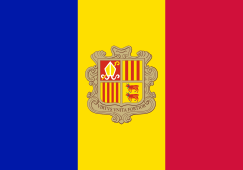 Andorra (2)
Andorra (2) -
 Argentina (9)
Argentina (9) -
 Armenia (2)
Armenia (2) -
 Australia (17)
Australia (17) -
 Austria (35)
Austria (35) -
 Belarus (16)
Belarus (16) -
.svg.png) Belgium (9)
Belgium (9) -
 Bosnia and Herzegovina (5)
Bosnia and Herzegovina (5) -
 Brazil (10)
Brazil (10) -
 Bulgaria (12)
Bulgaria (12) -
 Canada (54)
Canada (54) -
 Chile (8)
Chile (8) -
 China (23)
China (23) -
 Colombia (1)
Colombia (1) -
 Croatia (8)
Croatia (8) -
 Cyprus (1)
Cyprus (1) -
 Czech Republic (43)
Czech Republic (43) -
 Denmark (4)
Denmark (4) -
 Estonia (14)
Estonia (14) -
 Finland (42)
Finland (42) -
 France (32)
France (32) -
 Georgia (2)
Georgia (2) -
 Germany (44)
Germany (44) -
 Great Britain (16)
Great Britain (16) -
 Greece (3)
Greece (3) -
 Hungary (15)
Hungary (15) -
 Iceland (3)
Iceland (3) -
 India (1)
India (1) -
 Iran (2)
Iran (2) -
 Ireland (1)
Ireland (1) -
 Israel (2)
Israel (2) -
 Italy (37)
Italy (37) -
 Jamaica (1)
Jamaica (1) -
 Japan (31)
Japan (31) -
 Kazakhstan (20)
Kazakhstan (20) -
 Kenya (1)
Kenya (1) -
 Kyrgyzstan (1)
Kyrgyzstan (1) -
 Latvia (14)
Latvia (14) -
 Lebanon (2)
Lebanon (2) -
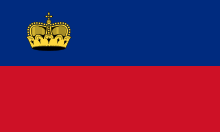 Liechtenstein (2)
Liechtenstein (2) -
 Lithuania (10)
Lithuania (10) -
 Luxembourg (1)
Luxembourg (1) -
 Macedonia (2)
Macedonia (2) -
 Malaysia (1)
Malaysia (1) -
 Mexico (2)
Mexico (2) -
 Moldova (2)
Moldova (2) -
 Monaco (1)
Monaco (1) -
 Mongolia (2)
Mongolia (2) -
 Montenegro (2)
Montenegro (2) -
 Nepal (1)
Nepal (1) -
 Netherlands (13)
Netherlands (13) -
 Norway (73) (Host)
Norway (73) (Host) -
 New Zealand (11)
New Zealand (11) -
 Poland (21)
Poland (21) -
 Portugal (1)
Portugal (1) -
 Romania (22)
Romania (22) -
 Russia (72)
Russia (72) -
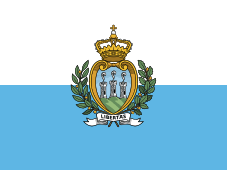 San Marino (1)
San Marino (1) -
 Serbia (3)
Serbia (3) -
 Slovakia (33)
Slovakia (33) -
 Slovenia (20)
Slovenia (20) -
 South Africa (1)
South Africa (1) -
 South Korea (30)
South Korea (30) -
 Spain (6)
Spain (6) -
 Sweden (39)
Sweden (39) -
 Switzerland (48)
Switzerland (48) -
 Chinese Taipei (4)
Chinese Taipei (4) -
 Timor-Leste (1)
Timor-Leste (1) -
 Turkey (13)
Turkey (13) -
 Ukraine (23)
Ukraine (23) -
 United States (62)
United States (62)
Calendar
| OC | Opening ceremony | ● | Event competitions | 1 | Event finals | EG | Exhibition Gala | CC | Closing ceremony |
| February | 12 Fri |
13 Sat |
14 Sun |
15 Mon |
16 Tue |
17 Wed |
18 Thu |
19 Fri |
20 Sat |
21 Sun |
Events |
|---|---|---|---|---|---|---|---|---|---|---|---|
| | OC | CC | |||||||||
| 2 | 2 | 1 | 1 | 1 | 1 | 1 | 9 | ||||
| |
2 | 2 | 1 | 1 | 6 | ||||||
| 2 | 2 | ||||||||||
| 2 | 2 | 2 | 6 | ||||||||
| |
● | ● | ● | ● | ● | 1 | ● | ● | 1 | 2 | |
| ● | ● | 2 | 2 | 1 | 5 | ||||||
| 2 | 2 | 1 | 1 | 6 | |||||||
| ● | ● | ● | ● | 1 | 1 | ● | ● | 2 | 4 | ||
| 1 | 2 | 1 | 4 | ||||||||
| 1 | 1 | 2 | |||||||||
| 2 | 2 | 1 | 5 | ||||||||
| 2 | 2 | ||||||||||
| 2 | 1 | 3 | |||||||||
| 2 | 2 | 1 | 1 | 1 | 7 | ||||||
| 2 | 2 | 1 | 2 | 7 | |||||||
| Total events | 6 | 11 | 12 | 13 | 4 | 5 | 7 | 8 | 4 | 70 | |
| Cumulative total | 6 | 17 | 29 | 42 | 46 | 51 | 58 | 66 | 70 | ||
| February | 12 Fri |
13 Sat |
14 Sun |
15 Mon |
16 Tue |
17 Wed |
18 Thu |
19 Fri |
20 Sat |
21 Sun |
Events |
Medal table
The top ten listed National Olympic Committees (NOCs) by number of gold medals are listed below with the host nation, Norway, being highlighted.
Medals won by teams of athletes from more than one NOC are included in the table as medals awarded to a mixed-NOCs team.
Host nation (Norway)
| Rank | Nation | Gold | Silver | Bronze | Total |
|---|---|---|---|---|---|
| 1 | | 10 | 6 | 0 | 16 |
| 2 | | 10 | 3 | 3 | 16 |
| 3 | | 7 | 8 | 9 | 24 |
| 4 | | 7 | 7 | 8 | 22 |
| 5 | | 4 | 9 | 6 | 19 |
| — | | 4 | 4 | 5 | 13 |
| 6 | | 4 | 3 | 4 | 11 |
| 7 | | 3 | 5 | 2 | 10 |
| 8 | | 3 | 2 | 1 | 6 |
| 9 | | 3 | 2 | 0 | 5 |
| 10 | | 3 | 0 | 2 | 5 |
References
- Bibliography
- Norwegian Olympic and Paralympic Committee and Confederation of Sports (NIF). "Candidate city for the Winter Youth Olympic Games: Lillehammer 2016" (PDF). Archived from the original (PDF) on 6 February 2011. Retrieved 6 February 2011.
- International Olympic Committee (IOC) (November 2011). "2nd Winter Youth Olympic Games in 2016: Report of the IOC Evaluation Commission" (PDF). Archived (PDF) from the original on 7 December 2011. Retrieved 7 December 2011.
- Lillehammer Olympic Organizing Committee (LOOC). "1994 Winter Olympics Report, volume III" (PDF). Retrieved 10 December 2010.
- Notes
- ↑ Lillehammer 2016 revises dates to coincide with 22-year anniversary of 1994 Olympics
- ↑ Lillehammer awarded 2016 Winter Youth Olympic Games
- ↑ "Lake Placid Should Consider 2016 Youth Games Bid - Rogge". GamesBids.com. Retrieved 2011-03-23.
- ↑ "Lake Placid Leaning towards 2020 Youth Games Bid". GamesBids.com. Retrieved 2011-03-23.
- ↑ Lucerne 2020 Informational brochure
- ↑ Publicado por piris. "Los Juegos de los Pirineos: ¿Zaragoza 2016 - Juegos Olimpicos de la Juventud?". Pirineos-olimpicos.blogspot.com. Retrieved 2011-03-23.
- ↑ Sofia To Bid For 2016 Winter Youth Games
- ↑ Sofia Out Of 2016 Youth Winter Games Bid
- ↑ Lillehammer named Winter Youth Olympic Games host for 2016
- ↑ Businesswoman appointed head of Lillehammer 2016
- ↑ Innsbruck 2012 brought to close as Olympic flag passed to Lillehammer 2016
- ↑ IOC (2011): 5
- ↑ LOOC (III): 18–22
- ↑ NIF: 10
- ↑ LOOC (III): 31–36
- ↑ NIF: 8
- ↑ LOOC (III): 37–41
- ↑ NIF: 12
- ↑ NIF: 32
- ↑ NIF: 24
- ↑ NIF: 16
- ↑ IOC (2011): 6
- ↑ NIF: 34–37
- ↑ NIF: 47
- ↑ LOOC (III): 14
- ↑ "Lillehammer 1 år igjen". Bergens Tidende (in Norwegian). 12 February 1993. p. 14.
- ↑ "Lillehammer 2016 Preliminary Website – Sports". Lillehammer 2016. Retrieved 6 June 2013.
- ↑ "Lillehammer 2016 Sports Programme" (PDF). 2014-06-13. Archived from the original (.pdf) on 2014-07-14. Retrieved 2014-12-30.
| Preceded by Innsbruck |
Winter Youth Olympic Games Lillehammer 2016 |
Succeeded by Lausanne |